![]()
Saint Patrick's Day Symbols
 |
One traditional symbol of Saint Patrick's Day is the Shamrock. "Shamrock" is the common name for several different kinds of three-leafed clovers native to Ireland. The shamrock was chosen Ireland's national emblem because of the legend that St. Patrick had used it to illustrate the doctrine of the Trinity. The Trinity is the idea that God is really three-in-one: The Father, The Son and The Holy Spirit. Patrick demonstrated the meaning of the Three-in-One by picking a shamrock from the grass growing at his feet and showing it to his listeners. He told them that just as the shamrock is one leaf with three parts, God is one entity with three Persons. The Irish have considered shamrocks as good-luck symbols since earliest times, and today people of many other nationalities also believe they bring good luck. |
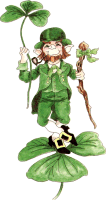 |
The name leprechaun comes from the old Irish word "luchorpan" which means "little body." A leprechaun is an Irish fairy who looks like a small, old man about 2 feet tall. He is often dressed like a shoemaker, with a crooked hat and a leather apron. According to legend, leprechauns are aloof and unfriendly. They live alone, and pass the time making shoes. They also have a hidden pot of gold! Treasure hunters can often track down a leprechaun by the sound of his shoemaker's hammer. If the leprechaun is caught, he can be threatened with bodily violence to tell where his treasure is, but the leprechaun's captors must keep their eyes on him every second. If the captor's eyes leave the leprechaun - he's known to trick them into looking away - he vanishes and all hopes of finding the treasure are lost. |
Believe it or not, the color of St. Patrick was not actually green, but blue! In the 19th century, however, green became used as a symbol for Ireland. In Ireland, there is plentiful rain and mist, so the 'Emerald Isle' really is green all year-round. The beautiful green landscape was probably the inspiration for the national color. Wearing the color green is considered an act of paying tribute to Ireland. It is said that it also brings good luck, especially when worn on St. Patrick's Day. Many long years ago, playful Irish children began the tradition of pinching people who forgot to wear green on St. Patrick's Day and the tradition is still practiced today. | |
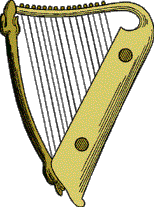 |
The harp is an ancient musical instrument used in Ireland for centuries. It is also a symbol of Ireland. Harpists, who were often blind, occupied an honored place in Irish society. Harpists and bards (or poets) played an important role in the social structure of Ireland. They were supported by chieftans and kings. Although it is not as recognizable as the shamrock, the harp is a widely used symbol. It appears on Irish coins, the presidential flag, state seals, uniforms, and official documents. O'Carolan was one of the most famous harpists, and many Irish melodies inspired by him still survive to this day. |
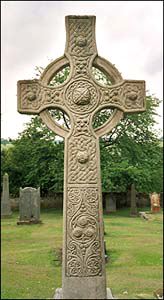 |
Saint Patrick was familiar with the Irish language and culture, because of his time as a slave there. When Patrick went back to Ireland to convert the Irish to Christianity, he was successful because he didn't try to make the Irish forget their old beliefs. He combined their old beliefs with the new beliefs. One example of this is the Celtic Cross. Saint Patrick added the sun, a powerful Irish symbol, onto the Christian cross to create what is now called a Celtic cross, so that the new symbol of Christianity would be more natural to the Irish. |
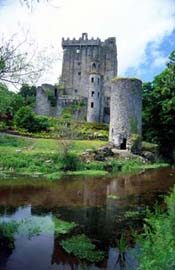 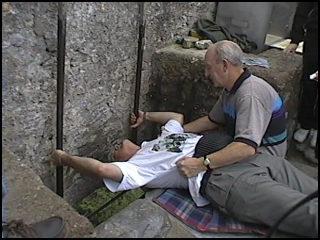 |
The word "Blarney" has come to mean nonsense or smooth flattering talk in almost any language. Tradition says that if you pay a visit to Blarney Castle in County Cork and kiss the Blarney Stone, you'll receive the gift of eloquence and powers of persuasion, a true master of the "gift of gab." The Blarney Stone is a stone set in the wall of the Blarney Castle tower in the Irish village of Blarney. The castle was built in 1446 by Cormac Laidhiv McCarthy (Lord of Muskerry) -- its walls are 18 feet thick (necessary to stop attacks by Cromwellians and William III's troops). Thousands of tourists a year still visit the castle. The origins of the Blarney Stone's magical properties aren't clear, but one legend says that an old woman cast a spell on the stone to reward a king who had saved her from drowning. Kissing the stone while under the spell gave the king the ability to speak sweetly and convincingly. It's difficult to reach the stone -- it's between the main castle wall and the parapet. Kissers have to lie on their back and bend backward (and downward), holding iron bars for support. The world famous Blarney Stone is situated high up in the battlements of the castle. Follow one of the several long, stone spiral staircases up to the top and enjoy the spectacular views of the lush green Irish countryside, Blarney House and The Village of Blarney. The stone is believed to be half of the Stone of Scone which originally belonged to Scotland. Scottish Kings were crowned over the stone, because it was believed to have special powers. The stone was given to Cormac McCarthy by Robert the Bruce in 1314 in return for his support in the Battle of Bannockburn. |